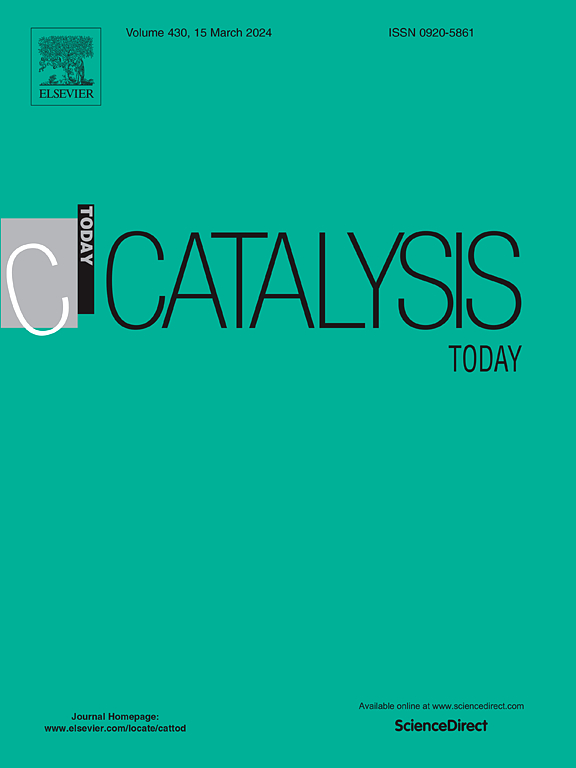油酸在酸性和碱性 ZSM-5 和 Y-zeolites 上的无氢脱氧:生物燃料产品和反应途径
IF 5.2
2区 化学
Q1 CHEMISTRY, APPLIED
引用次数: 0
摘要
作为废物产生的大量高酸性植物油可用于生产低成本生物燃料,而不会与粮食生产产生竞争。本研究调查了油酸(OA)在微热解装置中的转化情况,该装置采用了与石油原料流化催化裂化(FCC)类似的条件,将油酸作为脂肪化合物模型。评估了酸性 H 型和碱性 Na 型小微孔沸石(ZSM-5)和大微孔沸石(Y)对产物分布的影响。油酸预先吸附在沸石上,质量比为催化剂:油酸 = 10:1。纯油酸的热裂解受到限制,主要产生线性 1-烯烃和羧酸。在催化剂存在的情况下,转化率得到了提高,从而生成了更多种类的碳氢化合物。与 ZSM-5 相比,Y 型沸石上产生的支链烷烃和环状烷烃以及多芳烃的数量更多,这是因为 Y 型沸石的微孔直径更大。在各种催化剂中,Na-Y 催化剂生产的碳氢化合物数量最多,主要是汽油范围内的碳氢化合物。这些结果对于在催化裂化中协同处理脂肪残渣、促进第二代无须添加的生物燃料和生物基化学品的生产以及推动工业脱碳很有帮助。本文章由计算机程序翻译,如有差异,请以英文原文为准。
Hydrogen-free deoxygenation of oleic acid on acidic and basic ZSM-5 and Y-zeolites: Products for biofuel and reaction pathways
A large volume of highly acidic vegetable oils generated as waste could be utilized to produce low-cost biofuels without competing with food production. This study investigated the conversion of oleic acid (OA), used as a model fatty compound, in a micropyrolysis apparatus under conditions similar to those employed in fluidized catalytic cracking (FCC) of petroleum feedstocks. The influence of small-micropore size zeolites (ZSM-5) and large-micropore size zeolites (Y), in both their acidic H- and basic Na-forms, on the product distribution was evaluated. Oleic acid was pre-adsorbed onto the zeolites at a mass ratio Catalyst:OA = 10:1. Thermal cracking of pure oleic acid was limited, predominantly producing linear 1-alkenes and carboxylic acids. Conversion in the presence of catalysts was enhanced, resulting in the formation of a greater variety of hydrocarbons. Branched and cyclic alkanes, as well as polyaromatics hydrocarbons, were produced in greater quantities on Y zeolites compared to ZSM-5, due to the larger micropore diameter of the Y zeolite. Among the catalysts, Na-Y produced the highest number of hydrocarbons, predominantly within the gasoline range. These results are promising for the co-processing of fatty residues in the FCC, promoting the production of second-generation drop-in biofuels and bio-based chemicals, and contributing to industrial decarbonization.
求助全文
通过发布文献求助,成功后即可免费获取论文全文。
去求助
来源期刊

Catalysis Today
化学-工程:化工
CiteScore
11.50
自引率
3.80%
发文量
573
审稿时长
2.9 months
期刊介绍:
Catalysis Today focuses on the rapid publication of original invited papers devoted to currently important topics in catalysis and related subjects. The journal only publishes special issues (Proposing a Catalysis Today Special Issue), each of which is supervised by Guest Editors who recruit individual papers and oversee the peer review process. Catalysis Today offers researchers in the field of catalysis in-depth overviews of topical issues.
Both fundamental and applied aspects of catalysis are covered. Subjects such as catalysis of immobilized organometallic and biocatalytic systems are welcome. Subjects related to catalysis such as experimental techniques, adsorption, process technology, synthesis, in situ characterization, computational, theoretical modeling, imaging and others are included if there is a clear relationship to catalysis.
 求助内容:
求助内容: 应助结果提醒方式:
应助结果提醒方式:


